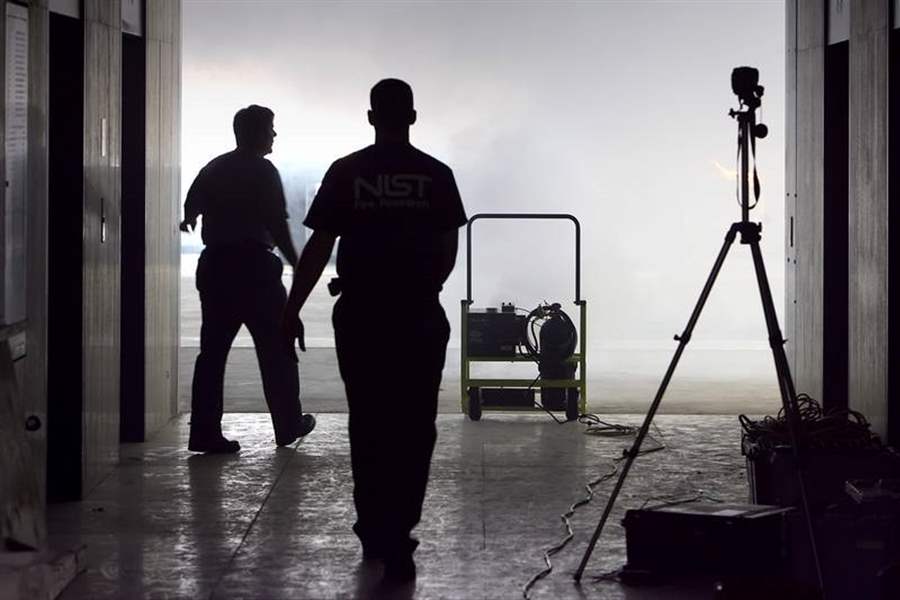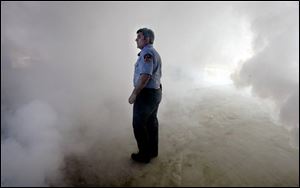
No inferno, just smoky experiment at high rise
6/16/2006
Lt. John Ciriello, left, and Steve Kerber of the National Institute of Standards and Technology carry out tests of positive-pressure techniques.

Lt. John Ciriello of the New York Fire Department, above, watches as smoke builds on the ground floor.
Smoke filled the ground floor of the vacant Fiberglas Tower in downtown Toledo yesterday morning as local fire officials and their counterparts from New York City and Chicago gathered to watch emergency workers pull a rescue hovercraft to the building's entrance.
But there was no fire in the 30-story office building, and it wasn't the scene of a rescue effort.
The departments were participating in a federally sponsored experiment to determine whether blowing air into burning high-rise buildings, a technique known as positive pressure ventilation, can keep smoke and heat out of stairways and possibly help save the lives of those trapped inside.
When the hovercraft experiment kicked off about noon, Washington Township firefighters placed their boat in front of one of the tower's entrances on St. Clair Street near Jefferson Avenue. With the craft fastened to a trailer hitch, they aimed its giant, 75- horsepower-driven propeller into the lobby and revved the engine - delivering an ear-popping roar that could be heard more than a block away.
"That's loud," exclaimed one bystander.

Lt. John Ciriello, left, and Steve Kerber of the National Institute of Standards and Technology carry out tests of positive-pressure techniques.
Moments later, smoke that was trickling from another open doorway in the building began pouring out onto the sidewalk.
It was the first time an experiment of its kind has been conducted, said Daniel Madrzykowski, fire protection engineer for the National Institute of Standards and Technology, an agency within the U.S. Commerce Department that sponsored the test at no cost to Toledo.
For the experiment, institute technicians wired every floor of the black- windowed building last weekend with pressure gauges, smoke detectors, and other instruments. Starting Monday, they began testing ways of blowing air into one of its stairwells to increase air pressure.
Higher pressure can limit the amount of smoke and heat that can get inside a stairway, making it easier for people trapped inside a burning building to escape.
The technicians are trying to determine how effective positive pressure ventilation can be, and the best ways to use it. Three officials from New York City's fire department and two from the Chicago Fire Department witnessed the tests to determine whether their cities' departments should start using positive pressure techniques when fighting high-rise fires.
"We've run over 160 experiments this week, and we're getting some good data," Mr. Madrzykowski said.
The institute initially lacked a venue for the tests, which require an empty, modern, high-rise office building. But in a passing conversation with Toledo Deputy Fire Chief John Coleman, officials learned about the Fiberglas Tower.
"It's very hard to find a vacant high-rise building," Chief Coleman said. "I said, 'Hey, I think I got one that I might be able to get us into.' "
The building has been vacant since 1996, when Owens Corning moved its headquarters to a nearby 45-acre campus. The building's owner, Eyde Co. in East Lansing, Mich., let fire officials use the tower for free.
Some fire departments have been using positive pressure techniques for years when combating fires in houses and small buildings. However, the strategies are employed less often when battling blazes in high-rise structures, generally considered as those over seven stories, because the techniques are still unproven in such circumstances, officials said.
There is a risk of fanning the flames and moving smoke into new parts of the building, said Jerry Tracy, a New York City battalion fire chief.
The week's experiments, which concluded yesterday, were intended to provide a better understanding of how the ventilation technique works.
"Unless we know we can do this safely and that it works, there's no point in even trying it," Chief Tracy said.
Institute engineers and researchers will spent the next several months analyzing the collected data. A report on the effectiveness of positive pressure techniques in tall buildings could be finished the end of the year, Mr. Madrzykowski said.
Toledo firefighters have been using the ventilation strategies since the mid-1980s, but the department hopes to refine its techniques through lessons learned from this week's tests, Chief Coleman said. Still, most of the department's experience has come from house fires, because high-rise fires are much less frequent.
"We get them, but we just don't get them as often as the big cities do," Chief Coleman said.
Contact JC Reindl at:
jreindl@theblade.com
or 419-724-6050.